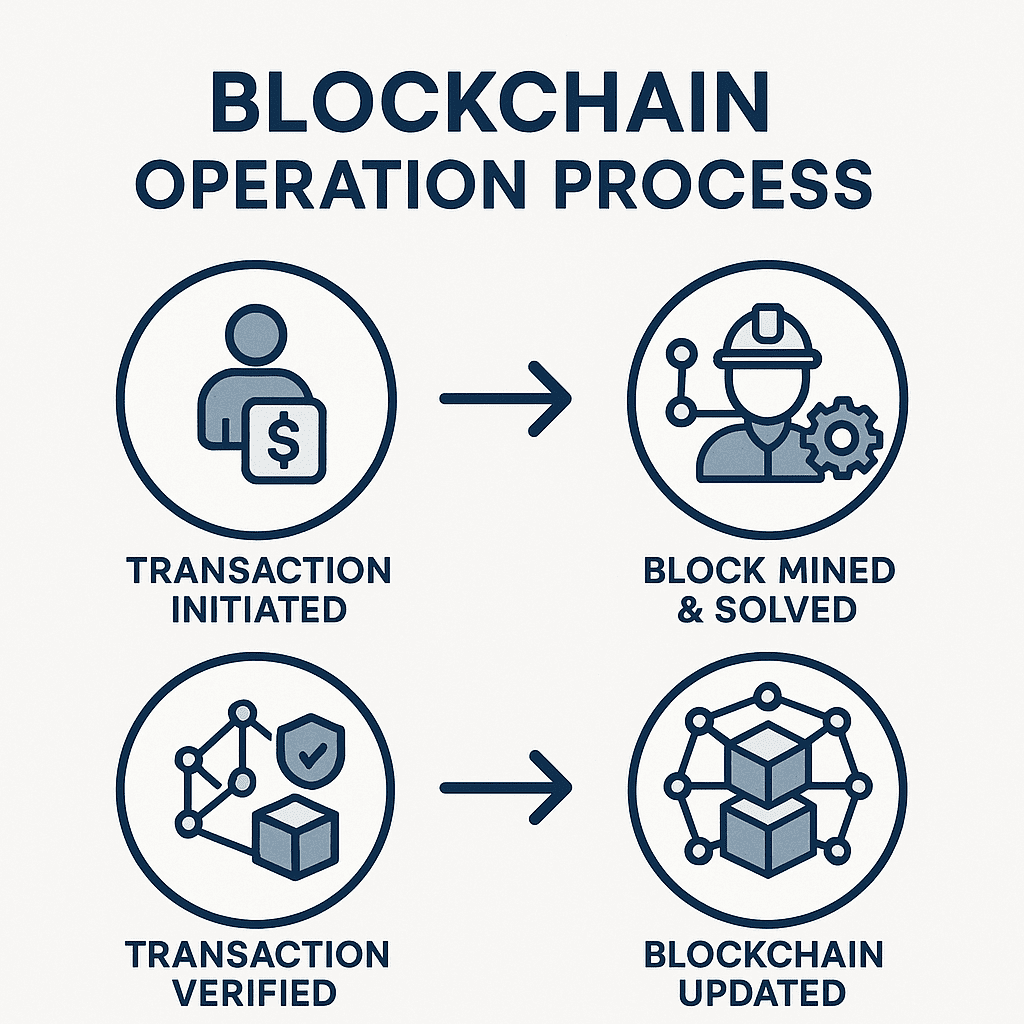1.1 ブロックチェーンの定義と起源
学習目標:ブロックチェーンの基本的な定義、その歴史的ルーツ、ビットコインとの密接な関係を理解する。
定義
ブロックチェーンは、データを「ブロック」と呼ばれる単位で整理・保存し、暗号原理を用いてこれらのブロックを順次連結して「チェーン」を形成する高度なデジタル台帳技術である。このチェーンは、複数のコンピュータノードにまたがって維持される分散型、透過型(パブリックブロックチェーンの場合)、耐改ざん性のある共有データベースを作成する。各ブロックには、特定の時間枠内の一連の取引が記録され、タイムスタンプが含まれるため、時系列順とトレーサビリティが保証される。
原点だ:
ブロックチェーン技術のコンセプトは、スチュアート・ハーバーとW・スコット・ストルネッタがデジタル文書のタイムスタンプの問題に対処するシステムを提案した1991年まで遡ることができる。しかし、ブロックチェーンが広く注目され、実際に応用されるようになったのは、2008年に「サトシ・ナカモト」というペンネームの謎の個人またはグループが、画期的なホワイトペーパーを発表したときである。 「ビットコイン:ピアツーピアの電子キャッシュシステム.ビットコインは世界で最初に成功した暗号通貨であり、ブロックチェーン技術の最初のキラーアプリケーションである。
1.2 ブロックチェーンの仕組み
学習目標:ブロックがどのように作成され検証されるのか、データの完全性を保証するためにどのようにチェーンが形成されるのか、ネットワークのコンセンサスを達成するためにマイナー(検証者)が果たす重要な役割について深く理解する。
ブロックチェーンの仕組みは、次のような循環プロセスとして要約できる。 "トランザクションのブロックへのパッケージ化 → チェーンにリンクされたブロック → ネットワークのコンセンサス保証".

ワークフロー:
- トランザクションの作成とブロードキャスト:
ユーザーが取引(デジタル資産の送金やスマート・コントラクトの実行など)を開始すると、その取引は署名され、ブロックチェーン・ネットワーク全体にブロードキャストされる。 - トランザクションの検証とブロックの作成:
ネットワーク内の特定のノード(プルーフ・オブ・ワーク(PoW)では「マイナー」、プルーフ・オブ・ステーク(PoS)では「バリデータ」と呼ばれる)は、保留中のトランザクションを収集する。彼らはトランザクションの正当性を検証し(例えば、送信者の残高や署名の有効性をチェックする)、検証されたトランザクションのバッチを新しい「ブロック」にパッケージする。それぞれの新しいブロックには、前のブロックの一意な識別子(ハッシュ)が含まれ、解読不可能なチェーンが形成される。 - 連鎖形成と不変性:
新しいブロックがコンセンサスメカニズムによって確認されると、既存のブロックチェーンに追加される。各ブロックはその前のブロックのハッシュを参照するため、過去のブロックを変更しようとすると、後続のすべてのブロックに連鎖的に変更が加えられることになり、改ざんは計算上不可能で簡単に検出できる。この設計により、データの完全性と不変性が保証される。 - 合意形成メカニズムと記録保持権:
ネットワークの参加者全員がブロックチェーンの状態に同意することを保証するために、コンセンサスメカニズムが採用される。例えば、ビットコインのPoWでは、マイナーは新しいブロックを作成する権利(「記録保持権」)を獲得し、ブロック報酬(新しく鋳造されたコインと取引手数料)を得るために、多大な計算資源を使って複雑な数学的パズルを解かなければならない。Proof of Stake(PoS)やDelegated Proof of Stake(DPoS)といった他のコンセンサスメカニズムは、運用方法は異なるが、公平で安全かつ効率的なネットワーク運用を確保するという目的は共通している。
1.3 ブロックチェーンの中核的特徴
学習目標:分散化、透明性、不変性、セキュリティ、仮名性など、ブロックチェーンの主な特徴を理解する。
主な特徴
- 地方分権:
データは単一の集中型サーバーに保存されるのではなく、ネットワーク内の何千ものノードにわたって維持・保存される。この分散アーキテクチャにより、単一障害点が排除され、中央集権的なエンティティの制御が大幅に軽減される。 - 透明性:
パブリック・ブロックチェーンでは、すべての取引記録(通常は仮名であり、実際のIDとはリンクしていない)が一般に公開されている。誰でもブロックチェーン・エクスプローラーを通じて取引履歴を照会・検証することができ、運営の透明性が確保される。 - 不変性:
データがブロックチェーンに書き込まれ、過半数のノードによって確認されると、一方的な改ざんや削除はほぼ不可能になる。これは暗号ハッシュリンクとコンセンサスメカニズムによって保証され、高い信頼性を提供する。 - セキュリティ:
暗号技術(デジタル署名やハッシュアルゴリズムなど)、分散型アーキテクチャ、合意メカニズムを組み合わせることで、ブロックチェーンはさまざまな攻撃(データの改ざんや二重支出など)に効果的に抵抗し、強固なセキュリティを提供する。 - 偽名性:
ブロックチェーン上のユーザーは、実世界のIDではなく、暗号アドレス(公開鍵から導出)で表される。取引データは公開されているが、ブロックチェーンのアドレスを実世界のIDにマッピングするには追加情報が必要であり、ある程度のプライバシーが提供される。 - コンセンサス主導:
ブロックチェーン上のすべての変更(新しいブロックの追加など)は、コンセンサスメカニズムを通じて確認されなければならず、データの一貫性と整然としたシステム運用が保証される。
1.4 ブロックチェーンのアーキテクチャと種類
学習目標:ブロックチェーン技術の一般的なレイヤーアーキテクチャーを理解し、パブリック、プライベート、コンソーシアムのブロックチェーンを区別する。
テクニカル・アーキテクチャ(一般モデル):
- データレイヤー:
ブロックチェーンの基盤で、取引の詳細、口座残高、デジタル署名、タイムスタンプ、ブロックをつなぐハッシュポインタなどの生データを保存する役割を担う。 - ネットワーク層(P2P層):
ピアツーピア通信ネットワークを構築する。トランザクションブロードキャスト、ブロック同期、ノード発見など、ノード間のデータ伝播を処理する。 - コンセンサス層:
ブロックチェーンの状態(PoW、PoSなど)についてネットワーク全体の合意を達成するためのルールとアルゴリズムを定義する。このレイヤーは公正で安全な記録保持と取引検証を保証する。 - インセンティブ・レイヤー:
主にパブリック・ブロックチェーンに存在するこのレイヤーは、採掘者/検証者がネットワークの維持に誠実に参加するインセンティブを与えるための経済モデル(ブロック報酬や取引手数料など)を設計する。 - 契約レイヤー:
スマートコントラクトの展開と実行を可能にする。スマートコントラクトは、契約条件を自動的に強制するあらかじめ書かれたコードである。これにより、ブロックチェーンの機能が単なる台帳としてではなくなる。 - アプリケーション層:
ブロックチェーン技術とエンドユーザーとの接点であり、分散型アプリケーション(DApps)やウォレット、分散型金融(DeFi)、サプライチェーンシステムなどのソリューションを含む。
ブロックチェーンの種類
- パブリック・ブロックチェーン:
完全にオープン。誰でも参加し、データを読み、トランザクションを送信し、コンセンサスに参加できる(例:ビットコイン、イーサリアム)。最高の分散性と透明性を提供する。 - プライベート・ブロックチェーン:
アクセスは単一の組織によって制限され、管理される。ノードの参加、データアクセス、コンセンサスの権利は一元管理される。企業内部のユースケースに適している。 - コンソーシアム・ブロックチェーン:
パブリック・ブロックチェーンとプライベート・ブロックチェーンのハイブリッドで、事前に選ばれた組織のグループによって管理される。効率性、プライバシー、部分的な分散化のバランスが取れており、産業コンソーシアムのような共同シナリオに最適。
1.5 ブロックチェーンの進化:1.0から3.0へ
学習目標:ブロックチェーン技術の発展段階をたどり、各段階の核となるブレークスルーと代表的なアプリケーションを理解する。
ブロックチェーン1.0プログラム可能なマネー
- 時代:デジタル通貨。
- ビットコインを筆頭に、分散型ピアツーピア電子キャッシュシステムに注力。
- 二重支出を解決し、安全でグローバル、検閲に強い通貨システムを構築。
ブロックチェーン2.0プログラム可能な金融
- 時代:スマートコントラクトと金融イノベーション
- イーサリアムが主導し、複雑な業務を自動化するスマートコントラクトを導入。
- 分散型アプリケーション(DApps)、DeFi、ICO、NFT、DAOを実現。
ブロックチェーン3.0 プログラマブル社会
- 時代:金融以外の幅広い応用
- サプライチェーン、ヘルスケア、デジタルID、IoT、投票システムなどへのブロックチェーンの統合に注力。
- AI、ビッグデータ、クラウドコンピューティングとの融合を重視し、社会の信頼問題を解決し、効率的なコラボレーションを可能にする。
1.6 用途と今後の動向
学習目標:ブロックチェーンの潜在的なユースケースを探り、その利点と課題を分析し、将来の方向性を予測する。
アプリケーション
- ファイナンス:クロスボーダー決済、貿易金融、デジタル本人確認、証券発行、保険自動化。
- サプライチェーン:エンド・ツー・エンドの製品トレーサビリティ、偽造防止、在庫最適化。
- ヘルスケア:電子カルテの安全な保存と共有、薬剤トレーサビリティ、臨床試験データ管理。
- 不動産:不動産登記の簡素化、資産のトークン化、取引コストの削減。
- 投票:安全、透明、検証可能な電子投票システム。
- 著作権保護:デジタルコンテンツの不変の所有権記録(NFT経由など)。
- エネルギー:ピアツーピアのエネルギー取引と効率的なエネルギー分配。
課題だ:
- スケーラビリティの問題(ビットコイン/イーサリアムでのTPSの低さなど)。
- 高いエネルギー消費(特にPoWシステムにおいて)。
- 規制の不確実性とコンプライアンス・リスク。
- 標準化と相互運用性の欠如。
- 複雑なユーザーエクスペリエンス(UX)。
- オープンネットワークにおけるプライバシーの問題
トレンドだ:
- レイヤー2ソリューション:スケーラビリティを向上させるロールアップ、サイドチェーン、チャンネル。
- 相互運用性:孤立したブロックチェーンをつなぐクロスチェーン・ソリューション。
- AI、IoT、ビッグデータとの統合.
- エンタープライズ・ブロックチェーン:業務効率化のための民間/コンソーシアム・ソリューションの採用。
- 分散型アイデンティティ(DID):デジタルアイデンティティをコントロールする権限をユーザーに与える。
- Web3とメタバース:没入型仮想世界と次世代インターネットのバックボーンとしてのブロックチェーン。

